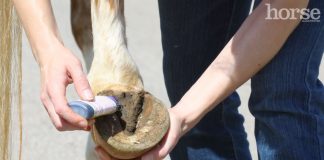Gastric ulcers can be considered the defining condition of a stressed horse because they are a common problem and can have relatively dramatic effects on a horse’s health.

When a horse is stressed, two things happen in the stomach that predispose it to ulcer formation. First, a stressed horse often has a decreased appetite. Less feed in the stomach means there is a reduced barrier between the gastric acid and the lining of the stomach. Secondly, elevated stress hormones affect the blood flow to the lining of the stomach, which decreases the stomach’s protective and healing abilities against its own acid. Both of these mechanisms work to create ulcerations along the lining of the stomach.
Not all horses with gastric ulcers behave the same way. Some have a decreased appetite, which only exacerbates the problem. Weight loss can then be seen with chronic ulcerations. Owners may also notice poor performance or a change in temperament. Some horses may even exhibit mild signs of colic or have intermittent episodes of loose feces. Others may grind their teeth.
Gastric ulcers are diagnosed via a tool called an endoscope. This is a small camera that is inserted into a horse’s nose, down his esophagus and into the stomach. An endoscopic examination gives your veterinarian an excellent view of the stomach lining. Gastric ulcers readily appear on camera, sometimes dramatically as bright red, irritated lesions. Others are only pinpoint erosions.
Omeprazole, marketed under the trade names UlcerGard and GastroGard, is the only FDA-approved gastric ulcer treatment currently on the market for equine use. It is a paste administered orally and works by inhibiting the production of gastric acid in the stomach. This allows the ulcers to heal and prevents the formation of new ones. Talk to your vet if you think your horse may need a prescription.
Back to The Stressed Horse >>
Overcoming Ulcers in Horses >>
This article originally appeared in the June 2015 issue of Horse Illustrated magazine. Click here to subscribe!






I appreciate your good article about equine stomach ulcers but I think it would be even more helpful if you included information about hindgut ulcers because many horses suffering from stomach ulcers also have hindgut ulcers. The products you suggested using do nothing to help heal hindgut ulcers and many horses could live happier, healthier lives if more was published on this topic. I know it’s not an easy topic because there is no quick fix for it, but it is a real issue.